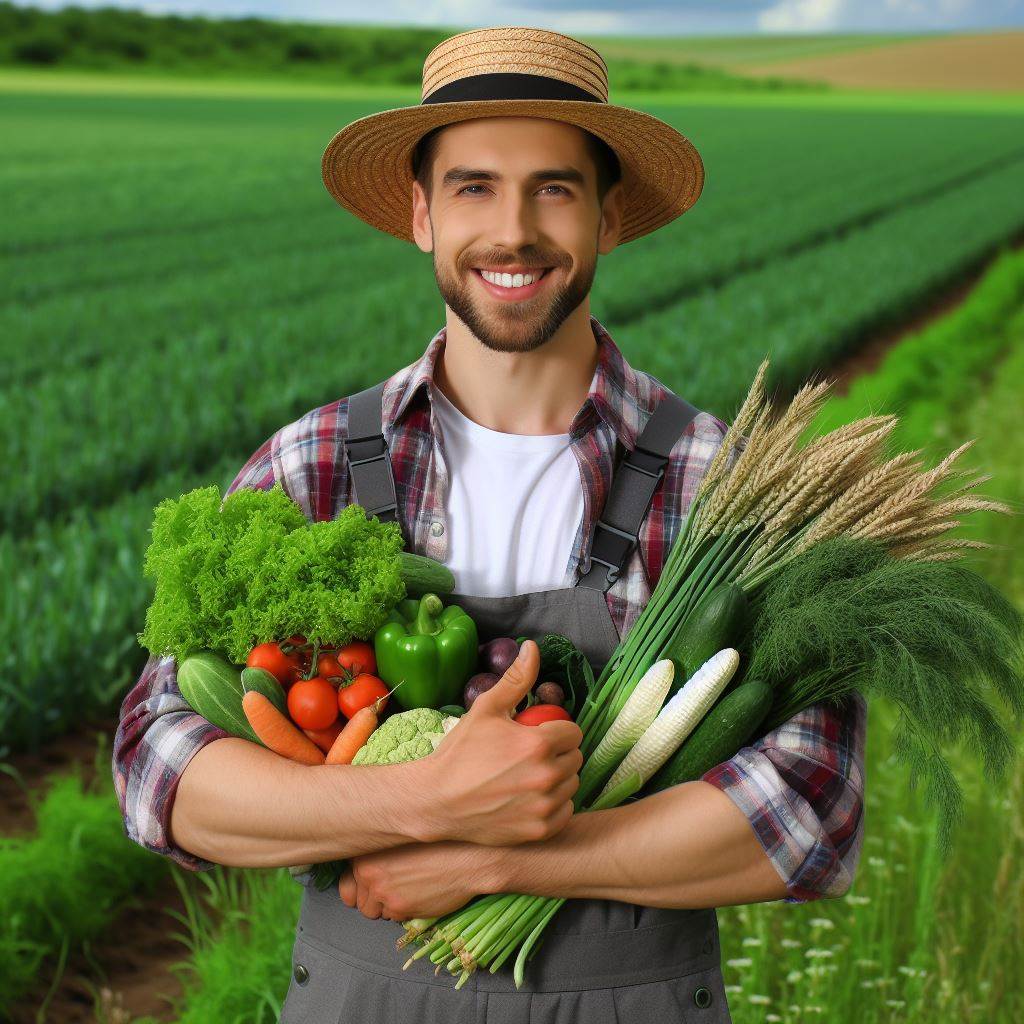Introduction
Community Supported Agriculture (CSA) is a partnership between farmers and local consumers to support sustainable farming practices.
As people become more health-conscious and environmentally aware, CSA has gained popularity for its numerous benefits.
The purpose of this blog post is to explain the concept of CSA, its benefits, and why it is growing in popularity.
CSA provides consumers with fresh, locally sourced produce and creates a direct relationship between them and farmers.
By joining a CSA, consumers receive a weekly or monthly share of the farm’s harvest.
This allows consumers to enjoy a variety of seasonal fruits, vegetables, and other farm products.
CSA supports local agriculture, promotes biodiversity, and reduces the carbon footprint associated with long-distance transportation of food.
Additionally, CSA encourages sustainable farming practices, such as organic and regenerative farming methods.
Joining a CSA also provides an opportunity for consumers to connect with their community and learn about food production.
By supporting local farmers, consumers contribute to the economic stability of the farming community.
In short, CSA is a beneficial partnership between farmers and consumers, providing fresh, sustainable, and locally sourced food.
Through CSA, individuals can support their local agricultural community and contribute to a healthier and more environmentally conscious food system.
Understanding CSA
What is a CSA?
Community Supported Agriculture (CSA) is a partnership between farmers and consumers that provides a direct link to fresh, locally grown produce.
This arrangement involves consumers purchasing a share of a farm’s harvest before the growing season, thus investing in the farm’s success.
Origin and History of CSA
- Roots in Japan and Europe: CSA’s origins trace back to Japan and Europe, but its transformative growth occurred in the United States.
- Emergence in the U.S.: Introduced to the U.S. in the 1980s, the CSA model gained momentum, reshaping the landscape of local agriculture.
- Visionaries Behind CSA: Visionaries like Jan Vander Tuin and Trauger Groh played pivotal roles in bringing the CSA concept to America
How CSA works for farmers and consumers
- Farmers Benefit: Farmers receive financial support before the season begins, helping with initial costs and reducing financial risks.
- Shared Risks and Rewards: CSA members share the risks and rewards of farming. A successful harvest benefits both farmers and consumers.
- Regular Distribution: In return for their investment, CSA members receive regular distributions of the farm’s produce throughout the growing season.
- Sustainable Farming Practices: CSA often promotes sustainable farming practices, encouraging environmentally friendly and community-focused agriculture.
- Direct Consumer-Farmer Relationship: CSA fosters a direct relationship between consumers and farmers, providing transparency and a deeper connection to food sources.
- Supporting Local Agriculture: Participating in a CSA supports local agriculture, reducing the environmental impact of transporting food long distances.
Understanding CSA involves recognizing its cooperative nature, linking consumers directly with the origins of their food.
Transform Your Agribusiness
Unlock your farm's potential with expert advice tailored to your needs. Get actionable steps that drive real results.
Get StartedThis model creates a mutually beneficial relationship, sustaining local farmers and providing consumers with a seasonal bounty of fresh, nutrient-rich produce.
Read: CSA Boxes: What to Expect
Benefits of Participating in a CSA
There are several incredible benefits to participating in a Community Supported Agriculture (CSA) program.
By joining a CSA, individuals can enjoy a variety of advantages such as:
Access to fresh, local, and seasonal produce
- Participating in a CSA allows individuals to have access to the freshest, locally-grown produce available.
- Since CSA farms usually operate within a close proximity to their members, the produce is often harvested the same day or within a day or two before it is delivered to the members.
- This means that the produce is at its peak freshness and retains more nutrients compared to store-bought alternatives.
Support for local farmers and the community
- By joining a CSA, individuals directly support local farmers and the community.
- CSA farms rely on the financial contributions of their members to sustain their operations.
- By participating in a CSA, individuals are investing in their local economy and helping to create a stronger and more sustainable food system within their community.
Building a connection between farmers and consumers
- A CSA helps build a connection between farmers and consumers.
- By becoming a member of a CSA, individuals can get to know the farmers who grow their food, learn about their farming practices, and develop a deeper appreciation for the hard work and dedication that goes into growing high-quality produce.
- This connection fosters a sense of trust and transparency in the food system.
Saving money and reducing food waste
- Participating in a CSA can also lead to significant cost savings and reduction in food waste.
- CSA members often receive a weekly or bi-weekly share of produce, which is typically more abundant and diverse than what they would purchase at a grocery store for the same price.
- Additionally, since the produce comes directly from the farm, there is less chance for it to spoil or go to waste.
In general, joining a CSA offers numerous benefits, including access to fresh, local, and seasonal produce, support for local farmers, building connections between farmers and consumers, as well as saving money and reducing food waste.
By participating in a CSA program, individuals can enjoy these advantages while simultaneously contributing to a more sustainable and resilient food system.
Read: CSA: Supporting Local Farms
Signing Up for a CSA
Research and find local CSA options
Start by doing some research to find local CSA options available in your area. Look for ones that are within a reasonable distance from your home.
Reach out to local farmers’ markets, agricultural extension offices, or use online directories to find a comprehensive list of CSAs near you.
Take your time to compare the different CSA farms and what they offer.
Consider factors such as the farm’s reputation, years of experience, and sustainability practices.
Understanding share options and pricing
Once you have a list of potential CSAs, it’s time to understand the different share options and pricing structures they offer.
CSA shares can come in various sizes and durations.
Some CSAs may offer weekly, biweekly, or monthly shares.
Transform Your Agribusiness Online Presence
Stand out with compelling content tailored to engage your audience and drive results. From blog posts to social media, we’ll create what your business needs to grow.
Get StartedCompare the prices of different CSA shares along with their contents.
Some CSAs may provide different types of produce or additional products like eggs or honey.
Considerations before signing up
Before committing to a CSA, there are a few important considerations to keep in mind:
- Dietary restrictions and preferences: If you have any dietary restrictions or preferences, make sure to inquire about the CSA’s ability to accommodate them.
Some CSAs may offer options for organic or pesticide-free produce, while others may have a wider variety of fruits and vegetables. - Commitment and pick-up arrangements: Understand the commitment level required by the CSA. Some CSAs may require members to pay upfront for the entire season.
Check if the CSA offers flexible pick-up arrangements that can accommodate your schedule. It’s important to find a convenient pick-up location and time that works for you. - Aesthetics and variety of produce: Consider the aesthetics and variety of produce that each CSA offers.
Some CSAs may focus on heirloom or unique varieties of vegetables.
If having a colorful array of produce is important to you, make sure to choose a CSA that aligns with your preferences.
By thoroughly researching local CSA options, understanding share options and pricing, and considering your personal preferences and needs, you can confidently sign up for a CSA that will provide you with a season of farm-fresh goodness.
Read: CSA & Food Security Links
What to Expect as a CSA Member
Box contents and variety
As a CSA member, you can expect a box filled with a variety of fresh, seasonal produce.
The contents of the box may vary each week, introducing you to new and exciting vegetables.
From leafy greens and root vegetables to fruits and herbs, the variety can be delightful.
Weekly or bi-weekly pick-ups
CSA members usually have the choice between weekly or bi-weekly pick-ups.
This flexibility allows you to choose the option that suits your schedule and consumption needs.
You can enjoy a regular supply of farm-fresh produce without the hassle of frequent trips to the supermarket.
Dealing with surplus produce
Sometimes, CSA members may receive an abundance of certain vegetables or fruits in their box.
Dealing with surplus produce requires creativity and resourcefulness. \
Consider preserving, freezing, or sharing with friends and neighbors.
Unlock Farming Insights for Growth
Make smarter farming decisions with detailed reports on market trends, weather patterns, and soil health tailored to your farm's success. Boost productivity with actionable data.
Get ReportAdditionally, you can try new recipes that incorporate these surplus items into your meals.
Tips for storing and using seasonal produce
To make the most of your CSA experience, it’s essential to know how to store and use seasonal produce properly.
Here are some practical tips:
- Handle with Care: Treat delicate produce like berries and tender greens gently to avoid bruising or damage.
- Storage Containers: Invest in storage containers suited for keeping fruits and vegetables fresh.
- Wash before Use: Rinse your produce just before using it to maintain its freshness.
- Meal Planning: Plan your meals around the produce you have to avoid waste and maximize usage.
- Learn New Recipes: Experiment with new recipes that make the most of seasonal produce. It’s a great opportunity to try new dishes.
- Preserve and Freeze: If you have an excess, freeze or preserve your produce to enjoy it later in the year.
- Support Local: Consider supporting local businesses when you need additional ingredients to complement your CSA produce.
Using these tips, you can savor the flavors of each season while reducing food waste and supporting local agriculture.
In a nutshell, becoming a CSA member offers many advantages, including receiving a variety of fresh, seasonal produce regularly.
The flexibility of weekly or bi-weekly pick-ups allows you to tailor the CSA experience to your schedule and needs.
While dealing with surplus produce can be a challenge, there are creative ways to make the most of it.
Lastly, by learning proper storage and usage techniques, you can fully enjoy the bounty of your CSA membership while minimizing waste.
Read: Seasonal Eating via CSA

Challenges and Solutions
CSA members may encounter several challenges throughout their membership, but with the right strategies and communication, these issues can be effectively addressed.
Possible challenges for CSA members
- Different types of produce in CSA boxes may pose a challenge for some members.
- Members may receive excess produce that they do not know how to use or store.
- CSA deliveries might not align with members’ personal schedules, causing inconvenience.
- Some members may struggle with adapting to new cooking and eating habits dictated by seasonal produce.
Strategies for managing surplus produce
- Share the surplus with family, friends, or neighbors who may appreciate fresh produce.
- Preserve or freeze excess produce to ensure it can be enjoyed throughout the year.
- Research recipes and experiment with new dishes using surplus produce.
- Liaise with other CSA members to organize swaps or trades for desired produce items.
Communication and feedback with the farmer
- Effective communication and feedback are vital in maintaining a positive CSA experience.
- Establishing open channels of communication with the farmer helps members address any concerns or questions directly.
- CSA newsletters, email updates, or social media groups can keep members informed about farm happenings, produce availability, and any last-minute changes or additions.
- Attending CSA events or farm visits allows members to meet the farmer and build a stronger connection to their food source.
- Providing feedback to the farmer, whether positive or constructive, ensures that members feel heard and allows the farmer to improve their practices based on member preferences.
Basically, CSA membership offers an array of benefits, but it can come with certain challenges.
By implementing the strategies outlined above and maintaining open communication with the farmer and other members, these challenges can be effectively managed.
The key to a successful CSA experience lies in embracing the seasonality, sharing surplus, trying new recipes, and actively participating in the CSA community.
Supporting CSAs Beyond Membership
When you become a member of a community-supported agriculture (CSA) program, you not only gain access to fresh, locally grown produce, but you also become part of a movement that supports local farmers and sustainable agriculture.
While your membership alone is a great way to contribute, there are other ways you can support CSAs beyond just being a member.
Spreading the word and promoting CSAs
One way to support CSAs is by spreading the word about their benefits and encouraging others to join.
Share your positive experiences with CSAs to friends, family, and community members.
Talk about the convenience of receiving fresh produce directly from the farm and the satisfaction of knowing where your food comes from.
By promoting CSAs, you can help build awareness and increase membership, which in turn supports local farmers.
Engaging in farm activities and events
Many CSA farms offer volunteer opportunities for their members and the community.
By engaging in farm activities and events, you can learn more about and appreciate the hard work and dedication of farmers.
Help with planting, harvesting, or even organizing farm events.
Not only does this support the CSA and its farmers, but it also allows you to connect with the land and gain a deeper understanding of the food system.
Advocating for local and sustainable agriculture
- CSAs are part of a larger movement towards local and sustainable agriculture.
- By advocating for CSAs and promoting the benefits of supporting local farmers, you can help encourage others to make informed choices about their food.
- Educate others about the environmental, social, and health advantages of eating locally and sustainably grown produce.
- When more people understand the significance of supporting CSAs, it can lead to positive changes in our food system.
Supporting CSAs beyond membership is an opportunity to be actively involved in shaping a more sustainable and resilient food system.
By spreading the word, engaging in farm activities, and advocating for local and sustainable agriculture, you contribute to the growth and success of CSAs and ensure the availability of fresh, healthy food for future generations.
Conclusion
Fresh, local produce, a direct farmer-consumer connection, and sustainable agriculture support.
Encourage exploration of local CSA options—experience the joy of seasonal, farm-fresh bounty.
Embrace the transformative journey of CSA. Connect with local farmers, savor the flavors of the season, and be a steward of sustainable and community-centric agriculture.
Your participation is not just a choice; it’s a meaningful step towards a healthier, more connected, and environmentally conscious way of living.
Consider this a call to action—join a CSA today, and let the farm-to-table journey enrich both your plate and your connection to the vibrant agricultural community around you.




